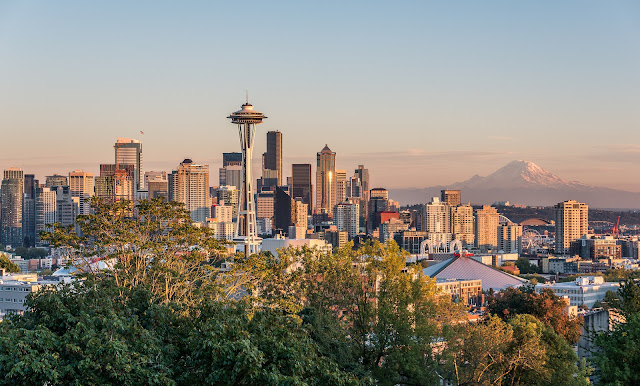Posted by Peter Zahler, Vice President of Conservation Initiatives
 |
| Mount Rainier peeks across the treetops. Photo by John Westrock via Flickr. |
I am one of the roughly 10,000 people who moved to the
Seattle area in 2018. Like most of those ten thousand-plus, I was drawn by the
unique quality of life found here
—the combination of a burgeoning economy
bringing unparalleled opportunity, and the extraordinary bounty of nature found
within easy reach of even city dwellers.
What I was astonished to discover is that the incredible spread
of nature’s palette across Washington was much greater than I first realized. Just
within western Washington it includes the huge sweep of the Olympic and
Cascade mountain ranges, rising to snow-capped peaks and covered in thick
forests of giant conifers and a moss-wrapped elfin understory; and the
expansive salt waters and coastal wetlands of Puget Sound and the fresh waters
of Lake Washington and the many rivers that run from the mountain to the sound.
I had heard of these pieces of Washington’s natural splendor—and like so
many, for me they were a big part of the draw that makes Seattle the fastest-growing
urban area in America—but I hadn’t fully appreciated their true extent.
 |
| Creek in the Quinault Rain Forest, Olympic National Park. Photo by Nagarajan Kanna via Flickr. |
For example, did you know that North Cascades National Park has the greatest number of glaciers of any location in the US outside of Alaska? Or that there are nearly 1,000 square kilometers of old-growth forest just within that one park? Or that the state has over 30 different designated Wilderness Areas totaling over 4.5 million acres of pristine landscape, protected in perpetuity?
These enormous expanses of intact wilderness are more than just a set of impressive facts and figures. Just a few hundred years ago most of the continent was one great wilderness from the Pacific to the Atlantic. Over the centuries those wild lands have been cut, carved, dismantled and built over until only pockets remain, dotted across our continent.
 |
| First winter coat on Twin Sisters Mountain in the Cascades. Photo by jaisril via Flickr. |
However, here in Washington we still have great swaths of intact ecosystems, some that still function as they have for millennia. The glaciers and thick forests are more than beautiful vistas. They provide the clean water that we drink and that help drive the economy, from commercial enterprises to the salmon whose incredible journeys from river to sea and back are intertwined with the history, culture, and ecology of the region. In terms of direct economic benefits, tourism is now the fourth-largest industry in Washington, with outdoor recreation bringing over $20 billion a year to the state.
These expansive landscapes draw people, but they also continue to provide a home to virtually the entire suite of wildlife that was here in the Pacific Northwest before Seattle was on any map.
Wolverines are rare and iconic flagships of true northern wilderness, dependent on deep snowpack and great trackless areas of the high mountains. Despite being driven to extinction in our state during the last century, they are now making an astounding comeback. So too is the wolf, just a few decades ago only a tale to tell our children and now back from local extinction with 27 packs roaming the greater Cascades region. The corgi-sized fisher, a relative of otters and weasels, is also being rapidly recovered in our forests, and their close kin the
cat-sized marten is doing well in the Cascades and may now be coming back in the Olympics.
The returning wolf, wolverine, fisher and marten join our state’s black bears, cougars, bobcats, Canada lynx, and coyote, along with moose, elk, mule and white-tailed deer, mountain goat, and bighorn sheep. Only large, healthy landscape can handle this wealth of diversity, and we are lucky enough to live in the middle of this cornucopia of wildlife and the intact ecosystems that support them—and us.
 |
| Bobcat in a backyard in King County. Photo by Daniel Toweill via Flickr. |
Woodland Park Zoo’s
Living Northwest Conservation Program actively works to save wildlife and habitat across Washington. Projects range from monitoring wolverines and lynx in the Cascades and marten in the Olympics to northwestern pond turtle and silverspot butterfly reintroduction and recovery, urban carnivore research in Seattle’s urban and suburban green spaces, citizen science initiatives, and education programs to help people and wildlife coexist.






Comments
Post a Comment